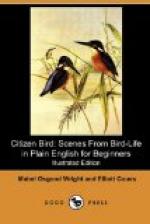[Illustration: American Crow.]
“It is perfectly right to do so, from our point of view. I, for one, do not wish Crows in my garden or about the Farm, where I see only the bad side of their characters. So we chase them away, and put scarecrows in the corn-fields. Do the Crows care? Not a bit! They laugh and talk about us behind our backs, and before our faces too. They pretend to be afraid, and fly away if a man appears a quarter of a mile off; but merely to settle down in another part of the field until their watcher tells them to move away again.
“There is a watcher for every flock, who gives the order to fly, and warns the troop at every approach of danger.
“Of course we must remember that for many months of the year the Crow eats grasshoppers, grubs, and even mice; but it is easy to forget this when one discovers that half a dozen Crows have eaten all the young Robins in the orchard, in a single morning.”
“Did they ever do that in our Orchard?” asked Dodo.
“Yes—not once, but many times; and that is the reason why I do not allow Crows to nest anywhere on the Farm. In great open farming districts, where other birds are few, they may do much more good than evil; but not in well-settled places or about gardens and pleasure grounds.”
The American Crow
Length from eighteen to twenty inches.
Glossy black from the tip of its beak to the end of its toes.
A Citizen of North America from the Fur Countries to Mexico.
A dismal and noisy neighbor for three mouths in the year, making itself hateful by destroying grain, and the eggs and young of song birds; but for the other nine a good citizen, working in the guilds of Ground Gleaners and Wise Watchers.
THE BLUE JAY
“This Jay is accused of the same bad tricks as the Crow—pulling up sprouting corn, eating ripe corn, and going birds’-nesting, to suck the eggs and eat the helpless young. But we must not judge the whole tribe by what we have seen a pair or two do in the Orchard or home woods in the mating season.
“The Blue Jay is the third of our really familiar blue birds and is certainly very handsome. Do you remember who the other two are?”
“The Bluebird!” said Dodo quickly. “And the Blue Sparrow!” cried Nat.
“You mean the Indigo Bird,” laughed Rap. “The Blue Jay is a queer bird, who can twist himself into all sorts of shapes. He sits one way when he sings, another when he is watching out for danger, and when he calls he is too funny for anything—he humps himself up and drops his tail as if he was falling apart, and then squawks!”
[Illustration: Blue Jay.]
“I see that you know this bird very well,” said the Doctor. “Have you seen his nest?”
“Once. It was in the miller’s woods, half-way up in a chestnut tree, and built just like a Crow’s, only much smaller. That season one of the Jays whistled and carried on till I thought there were ever so many birds together, and then laughed at me! They come round the mill for sweepings in winter, but they are almost as shy as Crows.”




